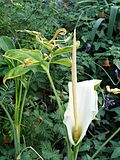Classification System: APG IV
Superregnum: Eukaryota
Regnum: Plantae
Cladus: Angiosperms
Cladus: Monocots
Ordo: Alismatales
Familia: Araceae
Subfamilia: Aroideae
Tribus: Areae
Genus: Dracunculus
Species: D. canariensis – D. vulgaris
Name
Dracunculus Mill., Gard. Dict. Abr. ed. 4, Dracunculus. 1754.
Lectotype species (designated by Nicolson, Taxon 24(4): 467. 1975): Dracunculus vulgaris Schott, Melet. Bot. 1: 17. 1832.
Synonyms
Heterotypic
Anarmodium Schott, Bonplandia (Hannover) 9: 368. 1861.
Type species: Anarmodium canariense (Kunth) Schott, Bonplandia (Hannover) 9: 368. 1861
Distribution
Native distribution areas:
References
Primary references
Miller, P. 1754. The Gardeners Dictionary. Abridged. Ed. 4, Vol. 1–3 (unpaged). John & James Rivington, London. DOI: 10.5962/bhl.title.79061 Reference page.
Additional references
Nicolson, D.H. 1975. Lectotypification of genera of Araceae. Taxon 24(4): 467–468. JSTOR
Boyce, P.C. 1994. The genera Dracunculus and Helicodiceros (Araceae: Aroideae). Thaiszia 4(2): 175–182. PDF Reference page.
Links
Govaerts, R. et al. 2014. Dracunculus in World Checklist of Selected Plant Families. The Board of Trustees of the Royal Botanic Gardens, Kew. Published on the internet. Accessed: 2014 Nov. 12. Reference page.
International Plant Names Index. 2014. Dracunculus. Published online. Accessed: Nov. 12 2014.
Tropicos.org 2014. Dracunculus. Missouri Botanical Garden. Published on the internet. Accessed: 2014 Nov. 12.
USDA, ARS, Germplasm Resources Information Network. Dracunculus in the Germplasm Resources Information Network (GRIN), U.S. Department of Agriculture Agricultural Research Service. Accessed: 23 March 2006.
Dracunculus is a genus of two species of a tuberous perennial of the family Araceae. They are characterised by a large purple spathe and spadix, often produced in advance of the pedate, dark green leaves often with white mottling. The open spathe is usually accompanied by a foul smell.
The best known species is Dracunculus vulgaris, which is sometimes grown in gardens for ornamental purposes.
They are native to the Mediterranean, Madeira and the Canary Islands where they are found in rocky areas, hillsides and waste ground.[2][3][1][4][5][6]
Species
| Image | Scientific name | Distribution |
|---|---|---|
 |
Dracunculus canariensis Kunth | Canary Islands, Madeira |
 |
Dracunculus vulgaris Schott | Turkey, Algeria, southern Europe (Spain, Italy, Portugal, France, Yugoslavia, Albania, Greece, Bulgaria); naturalized in scattered locations in the United States |
References
Govaerts, R. & Frodin, D.G. (2002). World Checklist and Bibliography of Araceae (and Acoraceae): 1-560. The Board of Trustees of the Royal Botanic Gardens, Kew.
Kew World Checklist of Selected Plant Families
The RHS Encyclopedia of Garden Plants, p379, Ed., Christopher Brickell, 1996, Dorling Kindersly, London. ISBN 0-7513-0436-0
Dobignard, D. & Chatelain, C. (2010). Index synonymique de la flore d'Afrique du nord 1: 1-455. Éditions des conservatoire et jardin botaniques, Genève.
Altervista Flora Italiana, Dragonea, Dracunculus vulgaris Schott includes photos plus European and North American distribution maps
Biota of North America Program, 2013 county distribution map
Retrieved from "http://en.wikipedia.org/"
All text is available under the terms of the GNU Free Documentation License

